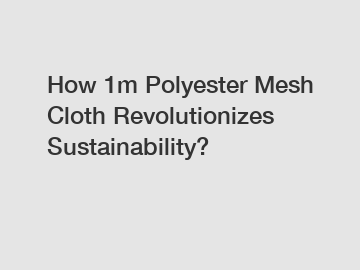How Does Sustainable Fashion Impact the Environment?
EcoPlas contains other products and information you need, so please check it out.
In an era where climate change looms large and the impacts of consumerism are increasingly undeniable, sustainable fashion is more than a mere trend—it's a necessary evolution. The garments we wear tell a story, not just about our personal style, but also about our values. Exploring how sustainable fashion impacts the environment reveals a complex tapestry of issues, opportunities, and innovations that can guide us toward a more sustainable future.
The fashion industry has long been criticized for its environmental footprint. From resource-intensive cotton production to the devastating effects of synthetic textile pollution, the implications of fast fashion are staggering. The rise of sustainable fashion offers a solution—one that not only minimizes harm but actively seeks to restore and regenerate. By embracing eco-friendly materials, ethical manufacturing practices, and circular economies, sustainable fashion addresses several key environmental challenges.
One of the principal benefits of sustainable fashion is its commitment to reducing carbon emissions. Traditional garment production is one of the leading contributors to greenhouse gas emissions. According to the UN, the fashion industry produces more emissions than all international flights and maritime shipping combined. Sustainable brands prioritize low-impact materials, such as organic cotton, Tencel, and recycled fabrics, that significantly lower their carbon footprint. Additionally, many sustainable brands utilize renewable energy sources in their production processes, helping to mitigate climate change.
Another critical aspect of sustainable fashion is the reduction of waste. The fashion cycle is notoriously short, with trends shifting rapidly, leading to massive amounts of textile waste in landfills. More than 92 million tons of waste are generated annually by the fashion industry, and this figure is projected to grow. Sustainable fashion combats this by promoting a circular economy, where products are designed for longevity and recyclability. Brands that produce timeless, durable pieces encourage consumers to invest in quality rather than quantity. Initiatives like clothing recycling programs and second-hand marketplaces further extend the lifecycle of garments, minimizing landfill contributions.
Water consumption is another environmental concern that sustainable fashion directly addresses. The conventional textile industry uses an astonishing amount of water—up to 20,000 liters to produce just one kilogram of cotton. This not only strains local water supplies but also contributes to water pollution through harmful runoff from dyes and chemicals. Sustainable fashion advocates for alternatives that require significantly less water, such as hemp or organic cotton, and promotes water recycling in production processes. Additionally, brands that use low-impact dyes minimize toxic runoff, contributing to cleaner waterways.
Furthermore, sustainable fashion takes a firm stand against pollution, particularly in terms of microplastics. Synthetic fabrics like polyester, while popular for their low cost and versatility, shed microfibers that eventually enter oceans and ecosystems, posing dangers to marine life and ultimately humans. By choosing natural fibers or recycled synthetics, sustainable brands aim to reduce this harmful impact. This benefit, combined with an emphasis on responsible production methods, allows consumers to enjoy fashion without compromising environmental integrity.
Additional resources:How Does Polypropylene Plastic Recycling Benefit Us?
How Do Different Types of Trailers Work?
Exploring Different Types of Hoses in 2024
How to Choose OEM Six Wire Spiral Hydraulic Hose?
Key Questions to Ask When Selecting a Premium Quality Six Wire Spiral Hydraulic Hose
How to Choose Steel Wire Braid Hydraulic Hose Cost?
Understanding DIN EN 856 4SH: Specs, Uses, and FAQs
On social and ethical fronts, sustainable fashion doesn't just protect the planet; it uplifts communities. Many sustainable brands prioritize fair labor practices, ensuring that workers receive fair wages and work in safe conditions. Ethical fashion not only advocates for environmental sustainability but also social equity, creating a holistic approach to addressing global challenges. This focus on ethical production empowers consumers to make more informed choices that align with their values, fostering a deeper connection between the maker, the wearer, and the world.
The impact of sustainable fashion extends beyond individual purchasing decisions. When consumers choose to support sustainable brands, they send a powerful message, prompting changes within the greater industry. With an increasing number of fashion enthusiasts advocating for ethical practices, larger mainstream brands are beginning to adopt sustainable initiatives. From launching eco-friendly collections to committing to carbon-neutral practices, corporate responsibility is evolving in response to consumer demand for genuine change.
Innovation is a key driver of this movement. Sustainable fashion is fueled by technology that enables smarter production processes, from 3D knitting to waste-detection software, which not only minimizes environmental impact but also enhances creativity. Brands are experimenting with new materials, biodegradable fabrics, and regenerative agriculture practices that bring life back to the earth. As technology progresses, the potential for sustainable fashion to innovate continues to grow, promising a future where style doesn't come at the cost of our planet.
Ultimately, sustainable fashion represents a profound shift in the way we approach clothing consumption. It challenges us to rethink our relationships with what we wear and the world around us. While it’s easy to overlook the connections between fashion and the environment, the choices we make as consumers can have far-reaching effects. By embracing sustainable alternatives, supporting ethical brands, and advocating for responsible practices, we can all contribute to a more equitable, resilient, and environmentally friendly fashion ecosystem. The path to a sustainable future is not just about the clothes we wear but about the values we embody as we walk that path.
If you want to learn more, please visit our website.
If you are looking for more details, kindly visit polypropylene plastic recycling.
Additional resources:How to Choose Hydraulic Steel Wire Braid Rubber Hose?
Top Trends in Fabric-Braided Hose for 2024
Is Your SAE 100 R16 Hose Meeting High-Pressure Demands?
100R17 Hydraulic Hose Specifications: Performance vs. Durability
Understanding SAE 100 R1 Hydraulic Rubber Hose
Discover the Benefits of Anti-Aging Polyester Mesh
Unlocking OEM EN856 4SP: Key Benefits and Insights









